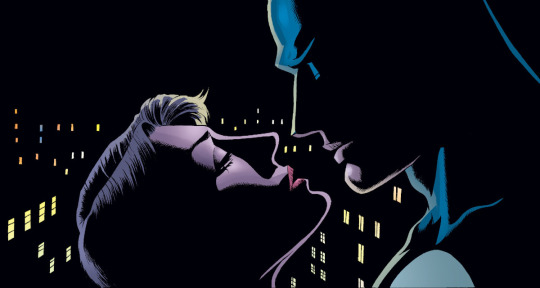#palmiotti plays it up as stylization
Text

March 2004. Selina and Batman have a moment in CATWOMAN #27. I have mixed feelings about the Ed Brubaker run, but it frequently looks cool.
#comics#catwoman#ed brubaker#paul gulacy#jimmy palmiotti#laurie kronenberg#batman#bruce wayne#selina kyle#batcat#batromance#gulacy's grasp of anatomy remains as odd as it was in the '70s#but rather than trying to “fix” it in the inks#palmiotti plays it up as stylization#which is an interesting choice that mostly works#I feel like selina isn't *this* much shorter than bruce#but dramatic license and such
11 notes
·
View notes
Photo


Some Brief Thoughts on a sequence from The Monolith
So I finally got around to reading some of The Monolith written by Jimmy Palmiotti and Justin Gray, illustrations by Phil Winslade, colors by Chris Chuckry, and letters by Nick Napolitano and Phil Balsman. The particular chunk I read was the first 3 issues that Palmiotti and Gray put out as a collection through Image comics. The Monolith was originally a 12 issue series published by DC from 2004-05, you can buy issues 1-5 and 9-12 on Paperfilms for. 99 cents, issues 6-8 were a Batman crossover that they can’t reprint/distribute.
The core of the series is split into two parts. In the present day readers follow Alice Cohen a recovering addict who inherits her Grandmother Alice’s old house in Brooklyn. She discovers that the house contains a creature, the titular Monolith, a Jewish Golem, that her mother and friends helped create during the Great Depression. The series than cross cuts between the Depression era setting and present day. Overall as a package The Monolith collection put out through Image is a nice introduction and reads well enough on its own, but is obviously open ended. Phil Winslade and Chris Chuckry’s art is excellent with the heavy use of black ink and reserved but surprisingly vibrant colors. They remind me of a more stylized Sean Philips and Val Staples (or I guess Sean and Jacob Philips at this point.)
A little context for these two pages, in the previous sequence Alice Cohen the Elder, Rabbi Rava, and Han discussed how their creation born from the blood of their murdered friend Peter was being, maybe a little, too Old Testament in his punishment of the Boroughs criminal element after the Monolith crippled a boy they deemed to be a “good kid” who must’ve been caught up in this criminal activity. There is an ambivalence that runs throughout this collection about the efficacy, ethics, surrounding the Monolith as a sentient being - is it Peter in a new body or a sort of “Anatomy Lesson” Swamp Thing - to their own roles in his creation. Alice the Elder’s journal entries guide readers through the Depression era in retrospect she seems deeply mournful and regretful for what role she played in all this.
The first page articulates that ambivalence surrounding the Monolith by implicating the reader in partaking in a straight forward articulation of Laura Mulvey’s Male Gaze* and how that gaze is constructed through comic books.
I am somewhat taken aback out Winslade’s depiction of Alice Cohen the Elder, she is shown in that ideal female beauty way that just doesn’t track for the setting. She may have been able to economically stabilize, thanks to the Monolith, but her physique is incongruous with the story being told in the Depression era. She is shown to be beauty par excellence because that’s how women are drawn in Big Two comics. There is also a level of unknowing sexuality to her depiction that gives it a slight Good Girl Art lean (which would fit the Depression era.)
Over the course of this page the readers voyeuristic gaze is merged with the voyeurism of Monolith. The reader is placed in the same perspective as this monstrous other, making the reader aware of their look and the less than ethical quality it featured. The sequence isn’t an absolute condemnation of the Monolith or the readers look but it does serve to reinforce the ambivalent feelings surrounding the title character, his potential humanity, and the potentially black and white view of morality he possess.
This ambivalence followed up by the next page as Monolith does what he was made to do: Punish the Evil that threatens Brooklyn and NYC at large. In this case that pedophile he promptly throws off the side of a building. This act and page is direct with a quick succession of actions, not the balanced extended temporarily of the previous page. There’s a Lying Cat quality to the Monolith due to reading it roughly 14 years after original publication.
The juxtaposition of this ambivalent page with a morally certain one helps to heighten the overall tension surrounding Monolith and what he is capable of. It’s good storytelling.
* I have my own issues with the limits of Mulvey’s theory on a theoretical-functional level but those limits have been thoroughly discussed over the past 40+ years and been expanded on and it is still a key foundational text.
#thoughts#The Monolith#comics#comic books#indiecomics#indie comics#Paper Films#phil winslade#Chris Chukry
0 notes